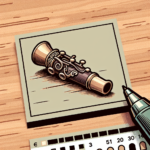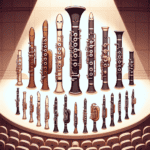Choosing the Right Clarinet Mouthpiece
Choosing the right clarinet mouthpiece can feel like finding a needle in a haystack sometimes! One key characteristic that every clarinetist should consider is the mouthpiece tip opening, which can greatly influence the overall sound and playability of the instrument.
Let's break it down! The mouthpiece tip opening refers to the space between the flat surface of the mouthpiece and the reed. This seemingly small detail can have a giant impact on how your clarinet behaves. The size of the opening can vary from narrow to wide, and each option has its own set of pros and cons!
Narrow vs. Wide Openings
If you're wondering how the size affects your sound, you're not alone! A narrow tip opening is usually easier to control—perfect for beginners or those who prefer a softer sound. You might find it a bit limiting in terms of projection, but hey, what it lacks in volume, it makes up for in finesse!
On the flip side, wider tip openings allow for a bolder sound, perfect for those looking to power through a big ensemble or need that oomph for solo performances. However, with great power comes great responsibility. Wider openings can be slightly trickier to handle, especially when it comes to producing softer dynamics.
| Tip Opening | Pros | Cons |
|---|---|---|
| Narrow | Easier control, softer sound | Limited projection |
| Wide | Bolder sound, better projection | Harder to control, especially for soft dynamics |
Martin Freres Mouthpieces
Have you heard of the Martin Freres brand? Known for their quality workmanship, Martin Freres mouthpieces are often a favorite among experienced players. Their mouthpieces offer a range of tip openings, making it easier to tailor your playing experience!
There's no one-size-fits-all answer when it comes to mouthpieces. For example, a larger mouthpiece may require an adjustment in your playing technique. You might need to modify your embouchure or adjust your air support. It's a good idea to keep a mouthpiece tip opening chart handy as you explore your options!
Understanding the Mouthpiece Tip Opening Chart
As you explore clarinet mouthpieces, you might come across a mouthpiece tip opening chart. This chart shows the measurements of the opening, allowing you to compare different models. Remember, this is a key factor in achieving the sound you want!
Some charts include recommended reed strengths for various openings, which can be incredibly helpful! They give you a better idea of how changes can affect your sound. Generally, the wider the tip opening, the stronger the reed you'll want to use. A larger tip opening with a softer reed might make you sound flat, while a harder reed could feel stiff.
Choosing Your Mouthpiece
If you're just starting out, consider a mouthpiece with a moderate tip opening, like those from Martin Freres. They offer a great balance for most playing styles and skill levels. Plus, they're typically reliable, easy to use, and can grow with you as a musician!
Mouthpiece Maintenance
Once you're ready to play, taking care of your mouthpiece is crucial! A well-maintained mouthpiece can stay playable for years. Regular cleaning with a mouthpiece brush helps prevent buildup of grime and bacteria. Don't forget to check the tip opening itself; over time, wear and tear can slightly change its dimensions!
Experimenting with Mouthpieces
For those of you who are performance-ready and want to explore new territory, trying different mouthpieces can be exciting! Experiment with various tip openings and depths to see how they uniquely affect your sound. The folks at Martin Freres would likely support this approach!
Conclusion
The clarinet mouthpiece tip opening chart is more than just a reference; it's a tool for unlocking your potential as a clarinetist. Whether you're a passionate beginner, an experienced player, or somewhere in between, understanding this aspect of your instrument is key to achieving your desired sound. Why not take some time to experiment and find what works best for you?
Remember, it's all about creating the sound that fits your musical style. So enjoy the process, and keep playing that clarinet with all the passion and joy you can muster!







